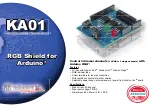
UG-1828
Preliminary Technical Data
Rev. PrC | Page 326 of 338
e.
The current frame is being played for frequency 1000 MHz, highlighted as blue.
f.
Next frame is assigned as Tx as well.
g.
Signal should appear at Tx output as 1000.001 MHz single tone.
14.
Repeat the last step.
Figure 315. Manual Frequency Hopping Using TES
h.
The current frame is advanced to the next 1000.001 MHz.
i.
The previous entry returned to the state Unassigned.
j.
The next frame is set to 1000.002 MHz.
k.
Signal should appear at Tx output as 1000.001 MHz single tone.
Rx Only
Rx only steps are the same for Tx Only shown in Tx Only. The only difference is user instead of click play on Transmit tab, must click play
on Receive tab.
TRx
TRx steps are also very similar. Except user must click play on both Transmit and Receive tabs before operating frequency hopping.
Note, upon reset, all frequencies entries should be assigned back to Unassigned.
Example 2: GPIO Controlled Frequency
Following the setup of
Example 1
through to step 8, the user can now look to implement GPIO controls with the following instructions.
1.
The user can enable separate gain and attenuation tables that correspond with a GPIO codes that can be called for individual
hops. This is done by loading tables into the Gain Table and Attenuation Table in the Frequency Hopping Tab.













































